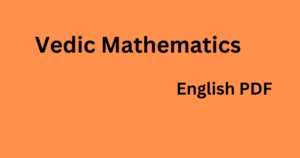
Vedic Mathematics is a system of mathematics that originated in ancient India, specifically during the Vedic period, which lasted from approximately 1500 to 500 BCE. This system of mathematics is based on sixteen sutras, or principles, and thirteen sub-sutras, which provide methods for solving mathematical problems more efficiently than traditional methods.
The origins of Vedic Mathematics are believed to lie in the Vedas, which are a collection of ancient texts that contain spiritual and philosophical teachings, as well as information on subjects such as astronomy, astrology, and mathematics. The Vedic period was a time of great intellectual and cultural development in India, and many of the ideas and concepts that were developed during this time continue to have an impact on Indian culture and society today.
The sixteen sutras of Vedic Mathematics cover a range of mathematical operations, including addition, subtraction, multiplication, division, and algebra. Each sutra provides a concise and elegant method for solving specific types of problems, and the system as a whole is designed to be highly efficient and easy to use.
One of the key features of Vedic Mathematics is its emphasis on mental calculation. Unlike traditional methods of mathematics, which rely heavily on paper and pencil calculations, Vedic Mathematics teaches students to perform calculations in their heads, using a combination of memory, visualization, and intuition.
This emphasis on mental calculation is not only more efficient, but it also helps students to develop their cognitive abilities and mental agility. By practicing Vedic Mathematics, students are able to improve their memory, increase their ability to focus and concentrate, and develop their problem-solving skills.
Another important aspect of Vedic Mathematics is its focus on patterns and relationships. Many of the sutras of Vedic Mathematics are based on patterns that are found in nature and in the universe, such as the Fibonacci sequence and the golden ratio. By studying these patterns and understanding their underlying mathematical principles, students are able to gain a deeper understanding of the underlying structure of the universe.
One of the most famous applications of Vedic Mathematics is its use in calculating large numbers. The system provides a range of methods for performing calculations involving large numbers, including multiplication, division, and squaring. These methods are not only more efficient than traditional methods, but they also help students to develop a deeper understanding of the underlying mathematical principles involved.
Vedic Mathematics has many benefits for students of all ages and abilities. For students who struggle with traditional methods of mathematics, Vedic Mathematics provides an alternative approach that is more intuitive and easier to understand. For students who excel at traditional methods, Vedic Mathematics provides a way to deepen their understanding of mathematical principles and develop their problem-solving skills.
In addition to its practical applications, Vedic Mathematics also has a rich philosophical and spiritual dimension. Many of the sutras and sub-sutras of Vedic Mathematics are rooted in ancient Indian philosophy and spirituality, and studying this system can help students to develop a deeper understanding of the connections between mathematics, science, and spirituality.
Overall, Vedic Mathematics is a fascinating and powerful system of mathematics that has the potential to revolutionize the way we teach and learn mathematics. By emphasizing mental calculation, patterns and relationships, and a deeper understanding of the underlying principles of mathematics, Vedic Mathematics provides a unique and valuable perspective on one of the most fundamental subjects in human history.